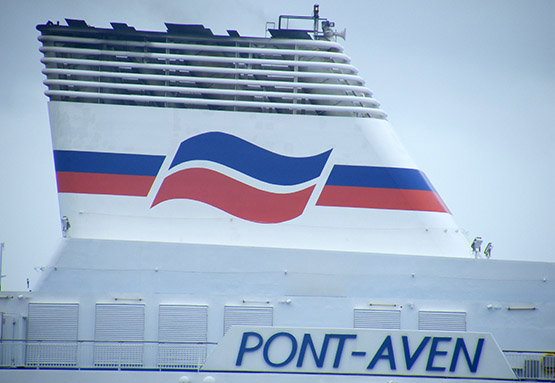#FerryScrubbers - Pont-Aven operated the final Cork-Roscoff round trip sailings last weekend with the Brittany Ferrries flagship scheduled to reopen the seasonal service in April 2016, writes Jehan Ashmore.
Saturday’s sailing also marked the last Irish-France crossing of the 2,400 passenger /650 cabin cruiseferry before the 41,748 tonnes ferry’s funnel are to be installed with 'scrubbers' this winter. The fitting of scrubbers are a result of new stricter 'green' controls following the EU Low Environmental Low Sulphur Directive that came into effect at the beginning of this year.
Pont-Aven will be unique in that she will be the only ferry operating in Irish waters during 2016 fitted with the sulphur emission scrubbers. This is due to the fact that the ferry also plies on the Roscoff-Plymouth route in the English Channel, one of several geographical zones that are under the EU directive to curb on emissions.
The Irish Sea nor surrounding waters are part of such a sulphur zone, SECA (Sulphur Emission Control Area). In addition to the English Channel, the other SECA zones include the North Sea and the Baltic.
Work to install the emission reduction technology on the 2004 German built Pont-Aven are understood to take place early next year at the Astander shipyard in Santander. The installation of scrubbers are essentially gas filters which allow the ferry to burn cost-effective heavy fuel oil, whilst still complying with new, stringent regulations applying to ships' emissions.
The Spanish port is also where the Pont-Aven serves a regular service to Plymouth.
So far the majority of Brittany Ferries fleet have undergone work to fit scrubbers, as briefy referred in Afloat, notably in the case of Normandie last year. It transpired following her return to the Caen (Oustreham)-Portsmouth route, the alteration of the funnel's appearance was rather boxy.
As for Pont-Aven, it will be interesting to see if the modifications carried out, albeit important, do not overwhelming detract from what is an overall attractive looking ferry.
The latest fleetmate currently receiving scrubbers is Normandie’s route-mate, Mont St. Michel. Likewise, the work is been currently carried out in Santander and is due to be completed in December.
Mont St. Michel sailings are instead been taken by Armorique, which stood down from her main Roscoff-Plymouth duties. In turn the most western English Channel route services are been maintained by Bretagne. As previously reported on Afloat.ie, Bretagne ended the final 2014 round trip sailings on the seasonal link to Ireland.
Getting into more technical details, a scrubber cleans the ship's exhaust, removing about 90% of the sulphur dioxide, this is to comply with new MARPOL VI limit of 0.1% sulphur emissions. They have the added benefit of removing about 70% of particulate matter which is also harmful to health.
One scrubber is required for each engine, which requires considerably investment, for example Pont-Aven has seven engines (four for propulsion, and three for electrical power). So each will require seven scrubbers.
Approximately, the cost is £10 million per ship - as well as the length of time it takes to install the scrubbers of around eight weeks. Afloat understands that Brittany Ferries are expected to pay more than €31m to complete the programme of installing the scrubbers across almost the entire ferry fleet.
During a recent sailing on board Armorique, a senior crew member commented to Afloat.ie that the 2009 Finnish built ferry will also undergo the work to install scrubbers between January and March.
Returning to the Irish route, Pont-Aven is scheduled to resume seasonal sailing service with the first inbound crossing to Cork on 1 April 2016. The outward return leg departs Ringaskiddy ferryport the next day on 2 April to Roscoff.






























































